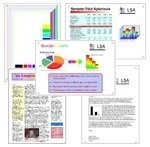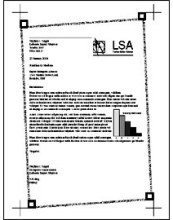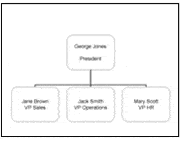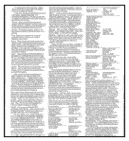 Brother HL-L8360CDW Toner Cartridges
Brother HL-L8360CDW Toner Cartridges

Save on all the consumables you need for your Brother HL-L8360CDW. Ordering from Printzone NZ doesn't just mean you get discounted products, but you also get to take advantage of our fantastic service! For the Brother HL-L8360CDW we stock the following:
Genuine Brother TN-441Y Yellow Toner
Maintain premium quality results, guarantee quality performance, with great value for money using Brother Original TN441 Yellow Toners. Brother employs…
Availability: In stock
Order Now - ships today
Price: 242.49 215.17 inc GST
Genuine Brother TN-443C Cyan Toner High Yield
Maintain premium quality results, guarantee quality performance, with great value for money using Brother Original TN443 High Yield Cyan Toners.…
Availability: In stock
Order Now - ships today
Price: 411.26 365.01 inc GST
Genuine Brother TN-443M Magenta Toner High Yield
Maintain premium quality results, guarantee quality performance, with great value for money using Brother Original TN443 High Yield Magenta Toners.…
Availability: In stock
Order Now - ships today
Price: 411.26 365.01 inc GST
Genuine Brother TN-443Y Yellow Toner High Yield
Maintain premium quality results, guarantee quality performance, with great value for money using Brother Original TN443 High Yield Yellow Toners.…
Availability: In stock
Order Now - ships today
Price: 411.26 365.01 inc GST
Genuine Brother DR-441CL Drum Unit
To keep printing at it's best, ensure that your printer has the best. Remember that no-one makes better parts and…
Availability: Low stock
Order Now - ships today
Price: 333.45 295.90 inc GST
Genuine Brother TN-446C Cyan Toner Extra High Yield
Print and save more With this extra high yield cartridge that holds more toner and prints more, resulting in a…
Availability: In stock
Order Now - ships today
Price: 460.78 408.94 inc GST
Genuine Brother TN-446M Magenta Toner Extra High Yield
Print and save more With this extra high yield cartridge that holds more toner and prints more, resulting in a…
Availability: In stock
Order Now - ships today
Price: 460.78 408.94 inc GST
Genuine Brother TN-446Y Yellow Toner Extra High Yield
Print and save more With this extra high yield cartridge that holds more toner and prints more, resulting in a…
Availability: In stock
Order Now - ships today
Price: 460.78 408.94 inc GST
Compatible Brother TN-443C Cyan Toner High Yield
This compatible high capacity cyan Brother TN443 toner cartridge is designed to provide you with high quality laser printing at…
Availability: In stock
Order Now - ships today
Price: 79.35 35.31 inc GST
Compatible Brother TN-443Y Yellow Toner High Yield
This compatible high capacity yellow Brother TN443 toner cartridge is designed to provide you with high quality laser printing at…
Availability: In stock
Order Now - ships today
Price: 79.35 35.31 inc GST
Compatible Brother TN-446BK Black Toner Extra High Yield
This compatible extra high capacity black Brother TN446 toner cartridge is designed to provide you with high quality laser printing…
Availability: Check Stock
Check ship times with us
Price: 124.20 55.20 inc GST
Compatible Brother TN-446C Cyan Toner Extra High Yield
This compatible extra high capacity cyan Brother TN446 toner cartridge is designed to provide you with high quality laser printing…
Availability: In stock
Order Now - ships today
Price: 124.20 55.20 inc GST
Compatible Brother TN-446M Magenta Toner Extra High Yield
This compatible extra high capacity magenta Brother TN446 toner cartridge is designed to provide you with high quality laser printing…
Availability: In stock
Order Now - ships today
Price: 124.20 55.20 inc GST
Compatible Brother TN-446Y Yellow Toner Extra High Yield
This compatible extra high capacity yellow Brother TN446 toner cartridge is designed to provide you with high quality laser printing…
Availability: In stock
Order Now - ships today
Price: 124.20 55.20 inc GST
Genuine Brother WT-320CL Waste Toner Pack
When your colour laser printer or multifunction prints a page, a small amount of toner residue is left on your…
Availability: In stock
Order Now - ships today
Price: 37.35 35.31 inc GST
Genuine Brother TN-441C Cyan Toner
Maintain premium quality results, guarantee quality performance, with great value for money using Brother Original TN441 Cyan Toners. Brother employs…
Availability: In stock
Order Now - ships today
Price: 242.49 215.17 inc GST
Genuine Brother TN-441M Magenta Toner
Maintain premium quality results, guarantee quality performance, with great value for money using Brother Original TN441 Magenta Toners. Brother employs…
Availability: In stock
Order Now - ships today
Price: 242.49 215.17 inc GST
Genuine Brother TN-443BK Black Toner High Yield
Maintain premium quality results, guarantee quality performance, with great value for money using Brother Original TN443 High Yield Black Toners.…
Availability: In stock
Order Now - ships today
Price: 249.56 221.49 inc GST
Genuine Brother TN-443 Toner High Yield Value Pack
Great value four-pack of toners at a discount compared with the single price. Order black, cyan, magenta and yellow in…
Availability: In stock
Order Now - ships today
Price: 1,483.35 1,316.52 inc GST
Genuine Brother BU-330CL Belt Unit
Bright and vibrant colour prints. Crisp black documents. Trouble free operation. Easy installation. Get this and more with genuine Brother…
Availability: In stock
Order Now - ships today
Price: 78.76 74.52 inc GST
Genuine Brother TN-446 Toner Extra High Yield Value Pack
Print more and save more with these extra high yield cartridges that hold more toner and prints a higher output,…
Availability: In stock
Order Now - ships today
Price: 1,606.63 1,425.89 inc GST
Compatible Brother TN-446 Toner Value Pack Extra High Yield
Pack includes: • 1 x compatible extra high yield black toner
• 1 x compatible extra high yield cyan toner
• 1 x…
Availability: Check Stock
Check ship times with us
Price:0.00 inc GST
Genuine Brother TN-446BK Black Toner Extra High Yield
Print and save more With this extra high yield cartridge that holds more toner and prints more, resulting in a…
Availability: In stock
Order Now - ships today
Price: 224.30 199.07 inc GST
Compatible Brother TN-443 Toner Value Pack High Yield PLUS EXTRA BLACK
Save, and enjoy the convenience, with our plus value pack of compatible TN443 toner! Sold at a discount to buying…
Availability: In stock
Order Now - ships today
Price: 389.85 194.93 inc GST
Compatible Brother TN-443 Toner Double Value Pack High Yield
Double your savings, and enjoy double the convenience, with our double value pack of compatible TN443 toner! Sold at a…
Availability: In stock
Order Now - ships today
Price: 627.90 313.95 inc GST
Genuine Brother TN-441BK Black Toner 3 PACK
Use a substantial amount of black? Then save BIG with our 3 pack at a discounted price!Maintain premium quality results…
Availability: In stock
Order Now - ships today
Price: 657.73 583.74 inc GST
Genuine Brother TN-443BK Black Toner High Yield 3 pack
Print a high black output? Save BIG with our 3 pack of black toners at a discount!Maintain Premium quality results…
Availability: In stock
Order Now - ships today
Price: 748.70 664.47 inc GST
Compatible Brother TN-443BK Black Toner High Yield
This compatible high capacity black Brother TN443 toner cartridge is designed to provide you with high quality laser printing at…
Availability: In stock
Order Now - ships today
Price: 75.90 33.70 inc GST
Genuine Brother TN-443 Toner High Yield Value Pack PLUS EXTRA BLACK
Get great value with this 5 pack of toners at a discount to single cartridges. Two black and one each…
Availability: In stock
Order Now - ships today
Price: 1,732.92 1,538.01 inc GST
Genuine Brother TN-443 Toner High Yield Double Value Pack
Get even greater value with this 8 pack of toners at a discount to single cartridges. Two each of black,…
Availability: In stock
Order Now - ships today
Price: 2,966.71 2,632.93 inc GST
Genuine Brother TN-443 Toner High Yield Triple Value Pack
Get amazing value with this 12 pack of toners at a discount to single cartridges. Three each of black and…
Availability: In stock
Order Now - ships today
Price: 4,450.06 3,949.45 inc GST
Genuine Brother TN-441BK Black Toner
Maintain premium quality results, guarantee quality performance, with great value for money using Brother Original TN441 Black Toners. Brother employs…
Availability: In stock
Order Now - ships today
Price: 219.25 194.58 inc GST
Genuine Brother TN-441 Toner Value Pack
Value and convenience in one with our TN441 value pack. Order the full set of toners at a discount in…
Availability: In stock
Order Now - ships today
Price: 946.71 840.19 inc GST
Compatible Brother TN-443M Magenta Toner High Yield
This compatible high capacity magenta Brother TN443 toner cartridge is designed to provide you with high quality laser printing at…
Availability: In stock
Order Now - ships today
Price: 79.35 35.31 inc GST
Compatible Brother TN-443 Toner Value Pack High Yield
Save, and enjoy the convenience, with our value pack of compatible TN443 toner! Sold at a discount to buying the…
Availability: In stock
Order Now - ships today
Price: 313.95 188.37 inc GST
Brother 250 Sheet Paper Tray LT-330CL
Up to 250 sheets lower tray. Compatible with Brother:HL-L8260CDWHL-L8360CDWHL-L9310CDWMFC-L8690CDWMFC-L8900CDWMFC-L9570CDWNote: Our shipping fee is based on metro/close regional shipping. In rare…
Availability: Check Stock
Check ship times with us
Price: 298.08 264.50 inc GST
Brother 500 Sheet Paper Tray LT-340CL
Up to 500 sheets lower tray. Compatible with Brother:HL-L8360CDWHL-L9310CDWMFC-L8900CDWMFC-L9570CDW Note: Our shipping fee is based on metro/close regional shipping. In rare…
Availability: Low stock
Order Now - ships today
Price: 394.08 349.72 inc GST
Compatible Brother TN-443BK Black Toner High Yield 2 PACK
Our twin pack comes at a better discount. These compatible high capacity black Brother TN443 toner cartridges are designed to provide…
Availability: In stock
Order Now - ships today
Price: 151.80 91.08 inc GST
Compatible Brother TN-443BK Black Toner High Yield 3 PACK
Our triple pack comes at an even better discount. These compatible high capacity black Brother TN443 toner cartridges are designed to…
Availability: In stock
Order Now - ships today
Price: 227.70 136.62 inc GST
Compatible Brother TN-443BK Black Toner High Yield 5 PACK
Our 5 pack comes with the biggest discount. These compatible high capacity black Brother TN443 toner cartridges are designed to provide…
Availability: In stock
Order Now - ships today
Price: 379.50 189.75 inc GST
Compatible Brother TN-443 Toner Triple Value Pack High Yield
Triple your savings, and enjoy triple the convenience, with our triple value pack of compatible TN443 toner! Sold at a…
Availability: In stock
Order Now - ships today
Price: 941.85 470.93 inc GST
Compatible Brother TN-443 Toner Value Pack High Yield
Save, and enjoy the convenience, with our value pack of compatible TN443 toner! Sold at a discount to buying the…
Availability: In stock
Order Now - ships today
Price: 313.95 188.37 inc GST
Compatible Brother TN-443BK Black Toner High Yield 2 PACK
Our twin pack comes at a better discount. These compatible high capacity black Brother TN443 toner cartridges are designed to provide…
Availability: In stock
Order Now - ships today
Price: 151.80 91.08 inc GST
Compatible Brother TN-443BK Black Toner High Yield 3 PACK
Our triple pack comes at an even better discount. These compatible high capacity black Brother TN443 toner cartridges are designed to…
Availability: In stock
Order Now - ships today
Price: 227.70 136.62 inc GST
Compatible Brother TN-443BK Black Toner High Yield 5 PACK
Our 5 pack comes with the biggest discount. These compatible high capacity black Brother TN443 toner cartridges are designed to provide…
Availability: In stock
Order Now - ships today
Price: 379.50 189.75 inc GST
Compatible Brother TN-443 Toner Value Pack High Yield PLUS EXTRA BLACK
Save, and enjoy the convenience, with our plus value pack of compatible TN443 toner! Sold at a discount to buying…
Availability: In stock
Order Now - ships today
Price: 389.85 194.93 inc GST
Compatible Brother TN-443 Toner Double Value Pack High Yield
Double your savings, and enjoy double the convenience, with our double value pack of compatible TN443 toner! Sold at a…
Availability: In stock
Order Now - ships today
Price: 627.90 313.95 inc GST
Compatible Brother TN-443 Toner Triple Value Pack High Yield
Triple your savings, and enjoy triple the convenience, with our triple value pack of compatible TN443 toner! Sold at a…
Availability: In stock
Order Now - ships today
Price: 941.85 470.93 inc GST
Genuine Brother TN-441BK Black Toner 3 PACK
Use a substantial amount of black? Then save BIG with our 3 pack at a discounted price!Maintain premium quality results…
Availability: In stock
Order Now - ships today
Price: 657.73 583.74 inc GST
Genuine Brother TN-441 Toner Value Pack
Value and convenience in one with our TN441 value pack. Order the full set of toners at a discount in…
Availability: In stock
Order Now - ships today
Price: 946.71 840.19 inc GST
Genuine Brother TN-443BK Black Toner High Yield 3 pack
Print a high black output? Save BIG with our 3 pack of black toners at a discount!Maintain Premium quality results…
Availability: In stock
Order Now - ships today
Price: 748.70 664.47 inc GST
Genuine Brother TN-443 Toner High Yield Value Pack
Great value four-pack of toners at a discount compared with the single price. Order black, cyan, magenta and yellow in…
Availability: In stock
Order Now - ships today
Price: 1,483.35 1,316.52 inc GST
Genuine Brother TN-446 Toner Extra High Yield Value Pack
Print more and save more with these extra high yield cartridges that hold more toner and prints a higher output,…
Availability: In stock
Order Now - ships today
Price: 1,606.63 1,425.89 inc GST
Genuine Brother TN-443 Toner High Yield Value Pack PLUS EXTRA BLACK
Get great value with this 5 pack of toners at a discount to single cartridges. Two black and one each…
Availability: In stock
Order Now - ships today
Price: 1,732.92 1,538.01 inc GST
Genuine Brother TN-443 Toner High Yield Double Value Pack
Get even greater value with this 8 pack of toners at a discount to single cartridges. Two each of black,…
Availability: In stock
Order Now - ships today
Price: 2,966.71 2,632.93 inc GST
Genuine Brother TN-443 Toner High Yield Triple Value Pack
Get amazing value with this 12 pack of toners at a discount to single cartridges. Three each of black and…
Availability: In stock
Order Now - ships today
Price: 4,450.06 3,949.45 inc GST
Compatible Brother TN-443BK Black Toner High Yield
This compatible high capacity black Brother TN443 toner cartridge is designed to provide you with high quality laser printing at…
Availability: In stock
Order Now - ships today
Price: 75.90 33.70 inc GST
Compatible Brother TN-443C Cyan Toner High Yield
This compatible high capacity cyan Brother TN443 toner cartridge is designed to provide you with high quality laser printing at…
Availability: In stock
Order Now - ships today
Price: 79.35 35.31 inc GST
Compatible Brother TN-443M Magenta Toner High Yield
This compatible high capacity magenta Brother TN443 toner cartridge is designed to provide you with high quality laser printing at…
Availability: In stock
Order Now - ships today
Price: 79.35 35.31 inc GST
Compatible Brother TN-443Y Yellow Toner High Yield
This compatible high capacity yellow Brother TN443 toner cartridge is designed to provide you with high quality laser printing at…
Availability: In stock
Order Now - ships today
Price: 79.35 35.31 inc GST
Compatible Brother TN-446BK Black Toner Extra High Yield
This compatible extra high capacity black Brother TN446 toner cartridge is designed to provide you with high quality laser printing…
Availability: Check Stock
Check ship times with us
Price: 124.20 55.20 inc GST
Compatible Brother TN-446C Cyan Toner Extra High Yield
This compatible extra high capacity cyan Brother TN446 toner cartridge is designed to provide you with high quality laser printing…
Availability: In stock
Order Now - ships today
Price: 124.20 55.20 inc GST
Compatible Brother TN-446M Magenta Toner Extra High Yield
This compatible extra high capacity magenta Brother TN446 toner cartridge is designed to provide you with high quality laser printing…
Availability: In stock
Order Now - ships today
Price: 124.20 55.20 inc GST
Compatible Brother TN-446Y Yellow Toner Extra High Yield
This compatible extra high capacity yellow Brother TN446 toner cartridge is designed to provide you with high quality laser printing…
Availability: In stock
Order Now - ships today
Price: 124.20 55.20 inc GST
Compatible Brother TN-446 Toner Value Pack Extra High Yield
Pack includes: • 1 x compatible extra high yield black toner
• 1 x compatible extra high yield cyan toner
• 1 x…
Availability: Check Stock
Check ship times with us
Price:0.00 inc GST
Genuine Brother TN-443BK Black Toner High Yield
Maintain premium quality results, guarantee quality performance, with great value for money using Brother Original TN443 High Yield Black Toners.…
Availability: In stock
Order Now - ships today
Price: 249.56 221.49 inc GST
Genuine Brother TN-443C Cyan Toner High Yield
Maintain premium quality results, guarantee quality performance, with great value for money using Brother Original TN443 High Yield Cyan Toners.…
Availability: In stock
Order Now - ships today
Price: 411.26 365.01 inc GST
Genuine Brother TN-443M Magenta Toner High Yield
Maintain premium quality results, guarantee quality performance, with great value for money using Brother Original TN443 High Yield Magenta Toners.…
Availability: In stock
Order Now - ships today
Price: 411.26 365.01 inc GST
Genuine Brother TN-443Y Yellow Toner High Yield
Maintain premium quality results, guarantee quality performance, with great value for money using Brother Original TN443 High Yield Yellow Toners.…
Availability: In stock
Order Now - ships today
Price: 411.26 365.01 inc GST
Genuine Brother TN-441BK Black Toner
Maintain premium quality results, guarantee quality performance, with great value for money using Brother Original TN441 Black Toners. Brother employs…
Availability: In stock
Order Now - ships today
Price: 219.25 194.58 inc GST
Genuine Brother TN-441C Cyan Toner
Maintain premium quality results, guarantee quality performance, with great value for money using Brother Original TN441 Cyan Toners. Brother employs…
Availability: In stock
Order Now - ships today
Price: 242.49 215.17 inc GST
Genuine Brother TN-441M Magenta Toner
Maintain premium quality results, guarantee quality performance, with great value for money using Brother Original TN441 Magenta Toners. Brother employs…
Availability: In stock
Order Now - ships today
Price: 242.49 215.17 inc GST
Genuine Brother TN-441Y Yellow Toner
Maintain premium quality results, guarantee quality performance, with great value for money using Brother Original TN441 Yellow Toners. Brother employs…
Availability: In stock
Order Now - ships today
Price: 242.49 215.17 inc GST
Genuine Brother TN-446BK Black Toner Extra High Yield
Print and save more With this extra high yield cartridge that holds more toner and prints more, resulting in a…
Availability: In stock
Order Now - ships today
Price: 224.30 199.07 inc GST
Genuine Brother TN-446C Cyan Toner Extra High Yield
Print and save more With this extra high yield cartridge that holds more toner and prints more, resulting in a…
Availability: In stock
Order Now - ships today
Price: 460.78 408.94 inc GST
Genuine Brother TN-446M Magenta Toner Extra High Yield
Print and save more With this extra high yield cartridge that holds more toner and prints more, resulting in a…
Availability: In stock
Order Now - ships today
Price: 460.78 408.94 inc GST
Genuine Brother TN-446Y Yellow Toner Extra High Yield
Print and save more With this extra high yield cartridge that holds more toner and prints more, resulting in a…
Availability: In stock
Order Now - ships today
Price: 460.78 408.94 inc GST
Genuine Brother DR-441CL Drum Unit
To keep printing at it's best, ensure that your printer has the best. Remember that no-one makes better parts and…
Availability: Low stock
Order Now - ships today
Price: 333.45 295.90 inc GST
Genuine Brother BU-330CL Belt Unit
Bright and vibrant colour prints. Crisp black documents. Trouble free operation. Easy installation. Get this and more with genuine Brother…
Availability: In stock
Order Now - ships today
Price: 78.76 74.52 inc GST
Genuine Brother WT-320CL Waste Toner Pack
When your colour laser printer or multifunction prints a page, a small amount of toner residue is left on your…
Availability: In stock
Order Now - ships today
Price: 37.35 35.31 inc GST
Brother 250 Sheet Paper Tray LT-330CL
Up to 250 sheets lower tray. Compatible with Brother:HL-L8260CDWHL-L8360CDWHL-L9310CDWMFC-L8690CDWMFC-L8900CDWMFC-L9570CDWNote: Our shipping fee is based on metro/close regional shipping. In rare…
Availability: Check Stock
Check ship times with us
Price: 298.08 264.50 inc GST
Brother 500 Sheet Paper Tray LT-340CL
Up to 500 sheets lower tray. Compatible with Brother:HL-L8360CDWHL-L9310CDWMFC-L8900CDWMFC-L9570CDW Note: Our shipping fee is based on metro/close regional shipping. In rare…
Availability: Low stock
Order Now - ships today
Price: 394.08 349.72 inc GST
When can I expect delivery of my Brother HL-L8360CDW Toner Cartridges?
Delivery is usually next business day (in over 92% of cases!) so you will get your order quick. Some customers in remote or far flung destinations, and customers who have RD addresses may experience some delays but be assured that we will find the quickest way to get your Brother HL-L8360CDW Toner Cartridges to you!Not only that, but delivery is FREE for the majority of our customers.
*Just spend 99.00 or more and you don't pay a cent for shipping, under 99.00, a moderate fee of $7 is charged. Printers and bulky paper items not included in free shipping.
How can I pay?

We accept payment by Visa, Mastercard, Paypal, Direct Bank Deposit and Internet Banking. We do not charge extra fees for using your credit card, ever!
Note: Direct deposit payments require clearance before shipment
Our site uses 256bit encryption ensuring your credit card details remain safe.
Brother HL-L8360CDW Description
<p>Brothers HL-L8360CDW Printer is designed for business, offering fast and accurate printing to maximise productivity and keep you ahead of the pack. With day-in-day-out high quality colour prints, the HL-L8360CDW features prints speeds of up to 31ppm, a 6.8cm intuitive touchscreen, USB, wired and wireless connectivity, a 300-sheet paper input, as well as NFC connectivity that allows you to print by touching your phone to your printer. And, with optional paper trays and super high-yield toners, youve got a printer that improves your efficiency and adds to your professionalism.</p>
<p>Brothers HL-L8360CDW Printer is designed for business, offering fast and accurate printing to maximise productivity and keep you ahead of the pack. With day-in-day-out high quality colour prints, the HL-L8360CDW features prints speeds of up to 31ppm, a 6.8cm intuitive touchscreen, USB, wired and wireless connectivity, a 300-sheet paper input, as well as NFC connectivity that allows you to print by touching your phone to your printer. And, with optional paper trays and super high-yield toners, youve got a printer that improves your efficiency and adds to your professionalism.</p>
How secure is Printzone NZ for ordering?
Very secure. Some very important points:Our site uses the highest level of encryption possible. If you are using a modern browser, communication of sensitive information (your personal details, credit card details etc) is at 256bit - that's the same as online banks and every other reputable online retailer. When you are on our secure pages and entering personal information, look for the green padlock in the browser bar.
Our website is hosted by a secure data centre in Auckland with restricted access and security vetting of all staff. Protected by firewalls and security programs, your information is safe from prying eyes.
We will never sell or trade your personal information. Some websites offer cheaper prices because they act as collectors for your personal information to on sell to third parties for marketing purposes. We will never do this. We only use your personal information to fulfill your order, and will only send you promotional email if you choose to receive them!
What are the top 10 reasons people buy from Printzone NZ?
- Lower Prices
- 5099 product lines in stock
- 92.2% of orders are delivered next working day
- Easy payment options - credit card, paypal, cheque or direct deposit
- Heavily secured website
- In business since 1999
- Real people working in a real store
- Toll free contact number
- 100% guarantee on all our products
- Save your favourites in myCartridges
Order Brother HL-L8360CDW Toner Cartridges now
Use the 'Add to Cart' buttons above to buy what you need now. If online ordering is not for you, but our Brother HL-L8360CDW Toner Cartridges offer is too good to turn down, then why not call us on 0800 000 853, and we will handle your order personally.Thank you for choosing Printzone NZ for your printer cartridges.



















































